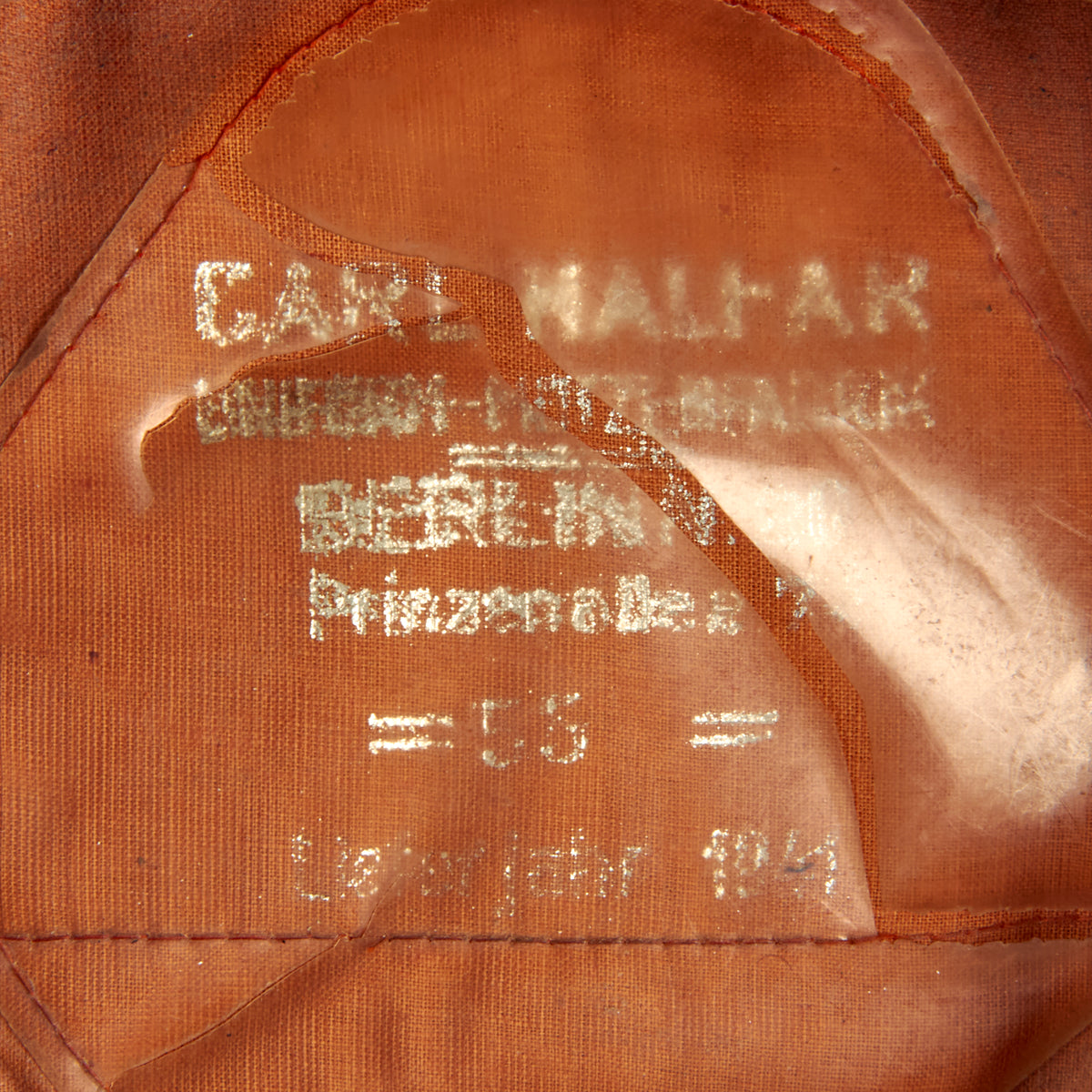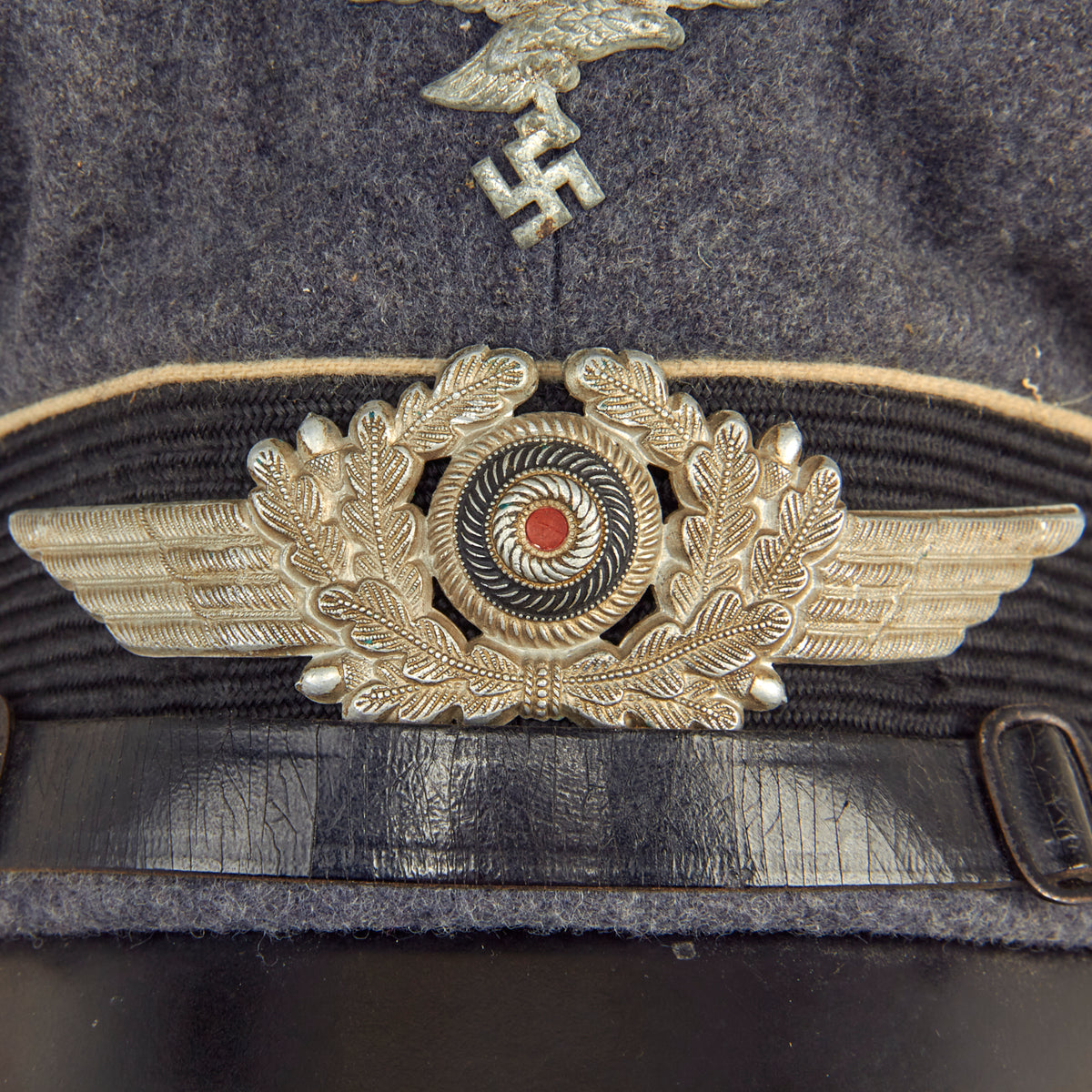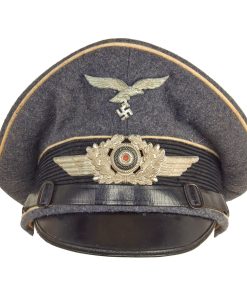Original German WWII 1941 dated Luftwaffe Division Hermann Göring EM/NCO Schirmmütze Visor Cap by Carl Halfar – size 55 Original Items
$ 1.895,00 $ 473,75
Original Item: Only One available. This is a very nice Luftwaffe Division Hermann Göring EM/NCO Schirmmütze (Visor Cap), a wonderful honest example with a fantastic “saddle-form” crushed shape. It has had the original crown stiffener removed, so the outer edge has that lovely shape that everyone loves. Officially called Fallschirm-Panzer-Division 1. Hermann Göring (1st Paratroop Panzer Division Hermann Göring), this Luftwaffe armored division is one of the most well known, and was very active during the war. Material from this unit is highly sought after on the market, and this is the first time we have had a visor cap from the unit.
The cap was made by the well-known firm of Carl Halfar, whose markings are still mostly visible inside the crown of the cap:
CARL HALFAR
UNIFORM-MÜTZENFABRIK
BERLIN. 20
Prinzenallee 74
= 55 =
Lieferjahr 1941
The last line indicates delivery in the year 1941, when the unit was still known as Regiment (mot.) Hermann Göring. Definitely some fantastic historic possibilities to this visor!
This NCO Schirmmütze Visor Cap is an original high quality manufactured cap. It is fabricated in Luftwaffe blue gray Fliegerblau (Flier’s Blue) wool gabardine, with wide black wool cap band, plus three rows of Weiß (white) color piping around the cap. This was the Waffenfarbe (Corps Color) for General Rank officers, as well as for Division Hermann Göring, named after the Luftwaffe Reichsmarschall himself.
Cap is decorated with the correct insignia, including a finely-detailed silver plated eagle on the peak, and an oak leaf wreath with stylized wings and central tri-color cockade on the band; the latter is made of aluminum with a red and black painted cockade. The black-finished patent leather EM/NCO chin strap rests upon the visor and is made up of three pieces: the central piece with two magnetic metal buckles and joined to the flanking end pieces via rectangular loops, the end pieces attached to black finished buttons on either side. It is still in very good condition, with the expected aging of the patent leather finish.
The visor is the classic matte black color with stitched edge trim, made of pressed vulcanfibre, with a green underside. The finish on the top is in good shape, with the edge trim still in great shape. The stitching holding the visor on however is quite loose, most likely having deteriorated over the decades.
The brown leather sweatband is in good condition, still somewhat supple, and is perforated along the front to provide better ventilation for the forehead. The ends of the sweatband pinned together in the rear. There is definitely wear to the sweatband, which is now discolored, and there is a tear all the way through on the forehead area, and another slanted tear on the rear left. The interior is lined with light brown light oilcloth. The top celluloid sweatshield is present, but torn at the stitching in several areas, with a large tear across the middle. The original markings are still present underneath.
This is a very nice service worn Luftwaffe Division Hermann Göring EM/NCO peaked visor cap, offered in very good used condition. Ready to display!
The Fallschirm-Panzer-Division 1. Hermann Göring (1st Paratroop Panzer Division Hermann Göring – abbreviated Fallschirm-Panzer-Div 1 HG) was an elite German Luftwaffe armoured division. The HG saw action in North Africa, Sicily, Italy and on the Eastern Front. The division began as a battalion-sized police unit in 1933. Over time it grew into a regiment, brigade, division, and finally was combined with the Parachute-Panzer Division 2 Hermann Göring in 1944 to form a Panzer corps under the by then Reichsmarschall. It surrendered to the Soviet Army near Dresden on May 8, 1945.
With the NSDAP seizure of 1933, Hermann Göring was appointed as Prussian Minister of the Interior. In this capacity, all Police units in Prussia came under Göring’s control. On 24 February 1933, Göring authorized the creation of a police battalion. Working in conjunction with Göring’s secret police, the Gestapo, the unit was involved in many attacks against Communists and Social democrats. In January 1934, under pressure from AH and Himmler, Göring gave Himmler’s SS control of the Gestapo. To reinforce the position of his remaining unit, Göring increased its size and instituted a military training program. During the Night of the Long Knives, the unit and Leibstandarte SS Adolf AH executed many SA leaders, removing the formation as a threat to the NSDAP.
In 1935, Göring was promoted to command of the Luftwaffe and ordered the unit transferred to the Luftwaffe, renaming it Regiment General Göring in September 1935. Two sub-units were separated from the regiment in March 1938 and redesignated German 1st Parachute Division, the first of the Fallschirmjäger (airborne) units. In 1936, the regiment was assigned for Göring’s bodyguards and as flak protection for AH’s Headquarters. The regiment participated in the annexation of Austrian (Anschluss) and the invasion of the Occupation of Czechoslovakia in 1938, and then in March 1939. During Fall Gelb, this force took part in the invasion of the Netherlands and Belgium.
During Operation Barbarossa, the regiment was attached to the 11th Panzer Division, a part of Army Group South. The regiment saw action around the areas of Radziechów, Kiev and Bryansk. In July 1942 the regiment was upgraded to brigade status, and then to full division in October 1942 as a Panzer division. While the division was in formation, the Second Battle of El Alamein had forced Field Marshal Erwin Rommel’s Afrika Korps to retreat to Tunisia. The division was sent to Tunisia piecemeal, where it eventually surrendered with the rest of Panzer Army Africa.
The reformed division was designated Panzer Division Hermann Göring and sent to Sicily. After the Allied invasion of Sicily was launched on 10 July 1943, the division was engaged at the Amphibious Battle of Gela and the Battle of Centuripe, retreating to Messina afterwards. When the armistice between Italy and Allied armed forces was signed, the division took part in the Operation Achse to disarm Italian troops. The division participated in the fighting following the Allied landing at Salerno in Operation Avalanche on 9 September. It then retreated towards the VolturnoTermoli line, and then to the Gustav Line, where it was pulled out of the line for rest and refit.
The Corps size Fallschirm-Panzerkorps Hermann Göring was created in 1944 through the combination of the unit with the Fallschirm-Panzergrenadier Division 2 Hermann Göring. After the start of the Allied offensive, Operation Diadem, on 12 May, the division retreated towards Rome and then abandoned the city. The division arrived in Poland in late-July and fought alongside SS Division Wiking and the 19th Panzer Division on the Vistula River between Modlin Fortress and Warsaw. In August, its counter-attack against the Magnaszew bridgehead, defended by the 8th Guards Army, failed after heavy fighting. Between August and September 1944, the division used captured Polish non-combatant civilians as human shields when attacking the insurgents’ positions during the Warsaw uprising. Following the destruction of the town, the division was attached to the newly formed Army Group Vistula formed 24 January 1945, defending the ruins of Warsaw in what AH termed “Festung Warschau”, or Fortress Warsaw. During the Vistula-Oder Offensive, much of the division was broken in battle.
In April, the remnants of the Hermann Göring Panzerkorps were sent to Silesia, and in heavy fighting were slowly pushed back into Saxony. On April 22, the Fallschirm-Panzer-Division 1. Hermann Göring was one of two divisions that broke through the inter-army boundary of the Polish 2nd Army (Polish People’s Army or LWP) and the Soviet 52nd Army, in an action near Bautzen, destroying parts of their communications and logistics trains and severely damaging the Polish (LWP) 5th Infantry Division and 16th Tank Brigade before being stopped two days later.
In early May, units of the corps attempted to break out towards the American forces on the Elbe, but were unsuccessful. The corps surrendered to the Red Army on 8 May 1945.
The German Schirmmütze Visor Cap:
The visor cap (Schirmmütze) was an important part of the headgear worn by German uniformed military, civil, paramilitary and political organizations during the Third Reich. This was the standard cloth headgear worn as a part of the service uniform. Visor caps were worn outdoors as well as indoors, and were often required to be worn by all personnel on duty. Visor caps were made in versions specific to each organization and were often further differentiated through the use of insignia, colored piping, or style of chin cord, to indicate rank, role or branch. The insignia used on these caps ranged from simple stamped metal emblems, to elaborate hand embroidery. Visor caps were issued to enlisted soldiers and NCOs in the military and in some other organizations. Officers had to purchase their own hats, and lower ranks could choose to purchase caps that were of a higher quality than the rather basic, issue examples. The private purchase caps were generally made in very high quality, with fine materials. A wide variety of fabrics were used, from Trikot and doeskin, to heavy wool, or even lightweight white fabric for summer wear. In the military, issue of these caps was generally suspended shortly after the outbreak of the war, but they continued to be worn by some troops until the end of the war.
Fast Shipping with Professional Packaging
Thanks to our longstanding association with UPS FedEx DHL, and other major international carriers, we are able to provide a range of shipping options. Our warehouse staff is expertly trained and will wrap your products according to our exact and precise specifications. Prior to shipping, your goods will be thoroughly examined and securely secured. We ship to thousands clients each day across multiple countries. This shows how we're dedicated to be the largest retailer on the internet. Warehouses and distribution centres can be located throughout Europe as well as the USA.
Note: Orders with more than one item will be assigned a processing date depending on the item.
Before shipping before shipping, we'll conduct a thorough inspection of the items you have ordered. Today, the majority of orders will be delivered within 48 hours. The delivery time will be between 3-7 days.
Returns
The stock is dynamic and we cannot completely manage it because multiple stakeholders are involved, including our factory and warehouse. So the actual stock may alter at any time. It's possible that you may not receive your order once the order has been made.
Our policy is valid for a period of 30 days. If you don't receive the product within 30 days, we are not able to issue a refund or an exchange.
You can only return an item if it is unused and in the same state as the day you received it. You must have the item in its original packaging.
Related products
Uncategorized
Uncategorized
Uncategorized
Uncategorized
Uncategorized
Uncategorized
Armoured Fighting Vehicles of the World: AFVs of World War One (Hardcover Book) New Made Items
Uncategorized
Uncategorized
Uncategorized
Uncategorized
Uncategorized
Armored Burgonet Helmet & Polearm from Scottish Castle Leith Hall Circa 1700 Original Items
Uncategorized
Australian WWII Owen MK1 Machine Carbine SMG Custom Fabricated Replica with Sling Original Items
Uncategorized
Uncategorized
Uncategorized
Uncategorized
Uncategorized
Uncategorized
Uncategorized












































































